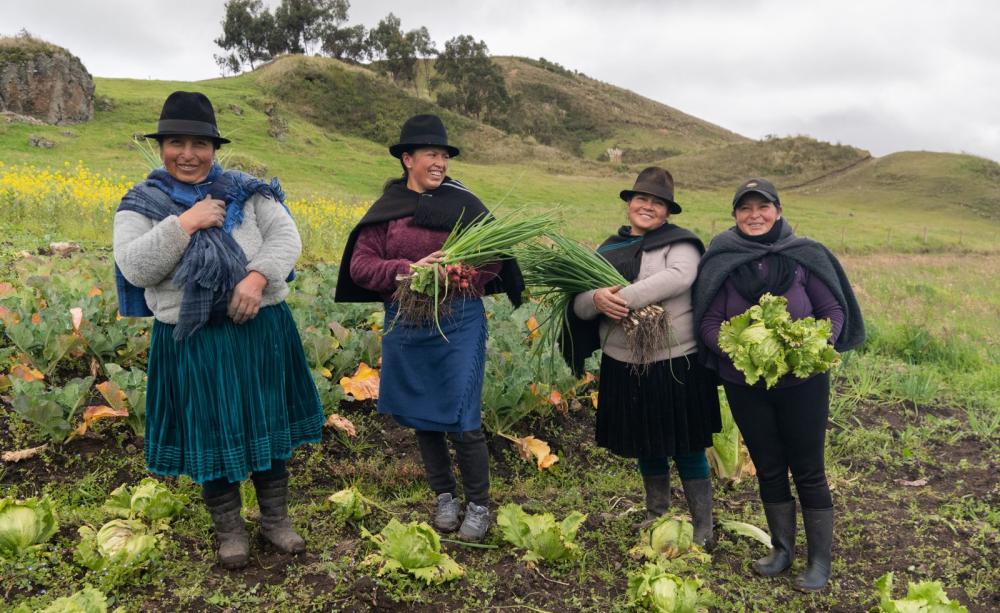Indigenous-led farmer associations are helping to reduce chronic malnutrition, which affects more than 20 per cent of children in Ecuador.
Families around the world are being forced to turn to the cheapest available food as climate extremes impact agriculture and exacerbate food price inflation – often at the expense of nutrition.
Those already facing the highest risks of food insecurity and malnutrition in low-income countries are bearing the brunt of the ongoing cost-of-living crisis.
Since 2020, food price inflation has outpaced overall inflation, according to the UN’s latest State of Food Security and Nutrition in the World report. By May of 2023, food price inflation in developing countries had risen by as much as 30 per cent.
Sovereignty
At the same time, overseas development assistance has declined and governments worldwide face continued economic pressures. These interconnected crises mean resource efficiency is no longer optional – it's essential for adaptation and survival.
Families and communities are being forced to do more with less, and governments are looking to optimise budgets, including development aid.
Important lessons can be found in Indigenous wisdom at this time, knowledge that is rooted in principles of circularity, regeneration and stewardship.
When it comes to making best use of available resources, Indigenous knowledge and practices offer sustainable approaches to meet demand for healthy, nutritious foods that do not cost the Earth.
Ecuador is a testament to the positive impact of Indigenous-led food systems. The indigenous populations from various nationalities and cultures have been key to the constitution's recognition of food sovereignty as a national priority.
Malnutrition
This framework explicitly values the fundamental role of Indigenous food systems in providing access to healthy, diverse, and culturally appropriate foods.
From providing fresh school meals to restoring biodiversity and strengthening farmer livelihoods, Indigenous communities are the frontline of sustainable food systems.
Indigenous-led farmer associations are helping to reduce chronic malnutrition, which affects more than 20 per cent of children in Ecuador.
For instance, Indigenous farming practices, such as intercropping, boost the availability of traditional foods, which promote dietary diversity while also allowing natural resources to replenish.
Other production methods like agroforestry – the integration of crops, livestock and forests – improve both food security and environmental health.
By producing diverse, nutrient-rich and culturally appropriate foods and supplying them to schools weekly, Indigenous-led farmer associations are helping to reduce chronic malnutrition, which affects more than 20 per cent of children in Ecuador.
Resilience
The Puerto La Boca Agro-Artisanal Association in Manabí, for instance, sources 30 fresh food items from around 17 producers, generating approximately US$6,000 in weekly sales.
Indigenous communities are also the custodians of agricultural biodiversity, resisting the trend to grow only one type of staple crop in favor of diverse, complementary crops that contribute to regenerative ecosystems.
Indigenous peoples were the first to domesticate forest produce to provide nourishment in the form of foods as we know it today. They have long safeguarded vital resources like seeds and advanced family farming, which still nourishes much of the world.
Some 64 per cent of the food we Ecuadorians consume comes from smallholder family farms. But their contributions go beyond food.
When it comes to ecosystem management, Indigenous communities are also the stewards of vital landscapes like mangroves, which play a key role in climate resilience.
Biodiversity
Native collectors of clams and crabs are actively restoring mangroves. In partnership with Heifer’s Future of Food Signature Program, Indigenous communities are responding to threats to these coastal forests from the logging industry and pollution.
The initiative is strengthening sustainable livelihoods, especially for Indigenous women in the mangrove ecosystem. Communities now care for more than 10,000 hectares of mangroves and after being connected to reliable markets, have more stable sources of income.
To address today’s economic and environmental challenges, more governments must fully uphold Indigenous rights as outlined in the UN Declaration on the Rights of Indigenous Peoples (UNDRIP).
As achieved in Ecuador, national policies should explicitly recognize the leadership and rights of Indigenous communities in governing natural resources and transforming food systems. Their participation must be structurally embedded in decision-making, not merely symbolic.
The international community has taken steps in this direction with delegates at the COP16 biodiversity talks in 2024 adopting a landmark decision to formally recognize Indigenous Peoples as key actors in biodiversity conservation.
Generations
This recognition must now extend to food systems, placing Indigenous communities – whose knowledge and practices have sustained ecosystems for generations – at the forefront.
This can be achieved through channelling resources and legal protections toward Indigenous-led initiatives. For instance, investing in community seed banks and upholding the rights of Indigenous Peoples to access and grow their traditional crops can strengthen Indigenous-led food systems and ensure plentiful, resilient food supplies.
Indigenous Peoples hold diverse knowledge of the circular economy, using resources sustainably to meet the needs of their communities without depleting the ecosystems on which they depend.
Returning to these time-tested practices and combining them with modern technology can build food systems that sustain a growing population for generations to come.
This Author
Rosa Rodriguez is the country director of Heifer Ecuador.




